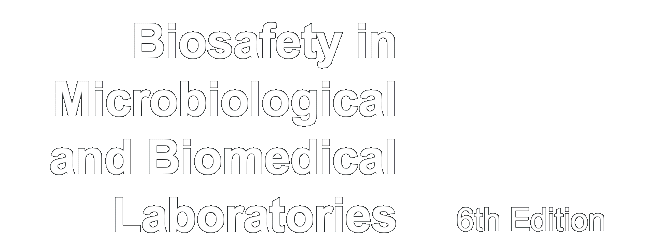Summary of Changes to the Biosafety in Microbiological and Biomedical Laboratories 6th Edition (BMBL-6)
This Summary of Changes was prepared by the ABSA International Technical and Regulatory Review Committee (TRR). May 2021
This Summary of Changes is not to be used as a substitute for the CDC/NIH BMBL-6 edition.
Table of Contents
II: Biological Risk Assessment
IV: Laboratory Biosafety Criteria
Biosafety Level 1 (BSL-1)
Biosafety Level 2 (BSL-2)
Biosafety Level 3 (BSL-3)
Biosafety Level 4 (BSL-4)
V: Vertebrate Animal Biosafety Level Criteria for Vivarium Research Facilities
Animal Biosafety Level 1
Animal Biosafety Level 2
Animal Biosafety Level 3
Animal Biosafety Level 4
VIII-F: Viral Agents Arboviruses and Related Zoonotic Viruses
Appendix B: Decontamination and Disinfection of Laboratory Surfaces and Items
Appendix C: Transportation of Infectious Substances
Appendix E: Arthropod Containment Guidelines
Appendix F: Select Agents and Toxins
Appendix G: Integrated Pest Management
Appendix H: Working with Human, NHP, and Other Mammalian Cells and Tissues
Appendix I: Guidelines for Work with Toxins of Biological Origin
Appendix J: NIH Oversight of Research Involving Recombinant Biosafety Issues
Appendix K: Inactivation and Verification
Section V – Vertebrate Animal Biosafety Level Criteria for Vivarium Research Facilities (pages 70-117)
Section V follows the basic organization and scope found in BMBL-5 Section I. The Introduction to Section V includes a paragraph which describes the training required in animal welfare, biosafety practices, PPE selection and the use of containment equipment. This section also identifies the responsibilities of the Biosafety Officer (BSO) and the Institutional Biosafety Committee (IBC) for protocol review and safety policies for the protection of personnel.
Section VI- Principles of Laboratory Biosecurity (pages 119-128)
Section VI describes biosecurity for microbiological and biomedical laboratories. Biosecurity has multiple definitions and applications depending on the industry and country. For the purposes of this section, laboratory biosecurity refers to measures designed to prevent loss, theft, or deliberate misuse of biological material, technology, or research-related information from laboratories or laboratory-associated facilities. The BMBL-6 refers to the ISO 350001-2019 when defining laboratory biosecurity.
The BMBL-6 added details to the term agricultural biosecurity encompassing broader measures to prevent contamination of food, health, and the environment. Included in this version are statements pertaining to personnel vetting, personnel reliability, violence prevention programs, laboratory biosecurity training, dual-use research oversight process, cybersecurity standards, material and facility control, and accountability standards. The BMBL-6 stresses the importance in balancing biosafety and biosecurity considerations when developing institutional policies or finding alternative solutions that blend the two.
Lastly, the Elements of a Laboratory Biosecurity Program remain essentially the same with a few exceptions: 1) The Personnel Management element includes clarification on personnel reliability and vetting/screening policies and 2) the objective of Information Security was expanded to include data integrity.
Section VII—Occupational Health Support for Biomedical Research (pages 130-141)
Section VII on Occupational Health (OH) has been revised with an explicit focus on a risk-based approach early and throughout the text. The section formally describes the need for, and the requisites of, an OH provider and OH program tailored to meet research needs. The title has been modified to include Occupational Health “Support for Biomedical Research” and removing “…and Immunoprophylaxis” broadening the description of Occupational Health appropriate to research.
The BMBL-6 Section VII introductory text is reduced to one paragraph which rapidly and clearly states the need for an appropriate Occupational Health Provider and biohazard-related Occupational Health Program that is risk-based with a focus that distinguishes it from, yet complements, the broader Occupational Health institutional program that serves all employees.
Text additions are quickly evident in the “Framework for Occupational Health Support of Biomedical Research” where five new subsections address the establishment, the conduct, and the compliance required of Occupational Health Programs. The varied approaches to meeting the Occupational Health need, the stakeholder collaboration, the frequent subject matter experts required, plus quality assurance are still included, previously in the introductory text, yet in a clearer presentation.
“Elements of an Occupational Health Program Supporting Biomedical Research” is a revision of the similarly titled portion in BMBL-5. Five new subsections are added to the previous for a total of eight topics. The risk of exposure (RoE) and risk of adverse health consequences or disease (RoD) are new concepts introduced in the subsection “Clinically-Oriented, Post-Exposure Risk Assessment”.
The elevated risks of handling RG3 and RG4 agents is woven throughout various portions of the text, such as under the OH program design, and is elaborated further in the expanded “Occupational Health support for High and Maximum Containment”, replacing the separate BSL-4 OH section in BMBL-5.



